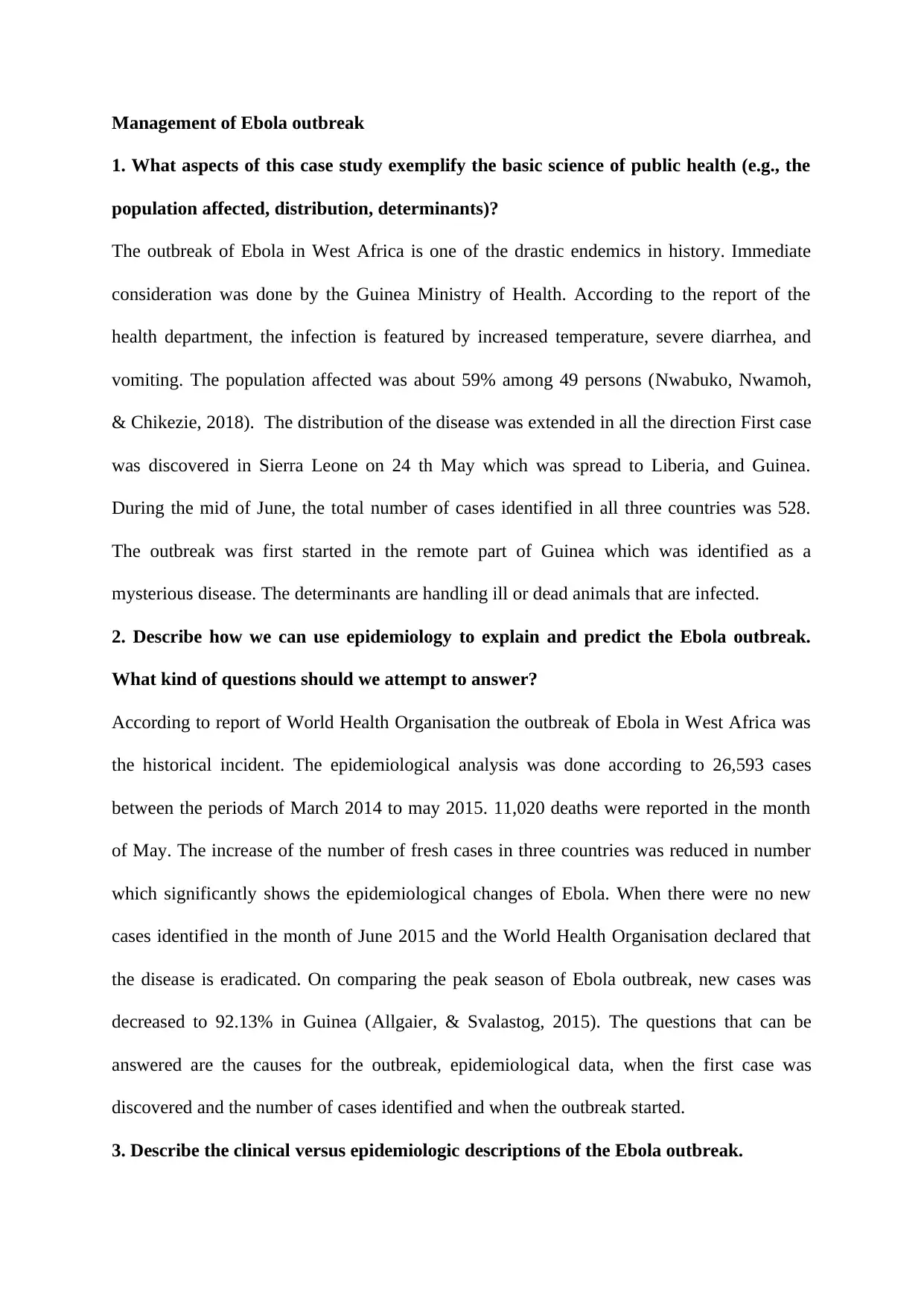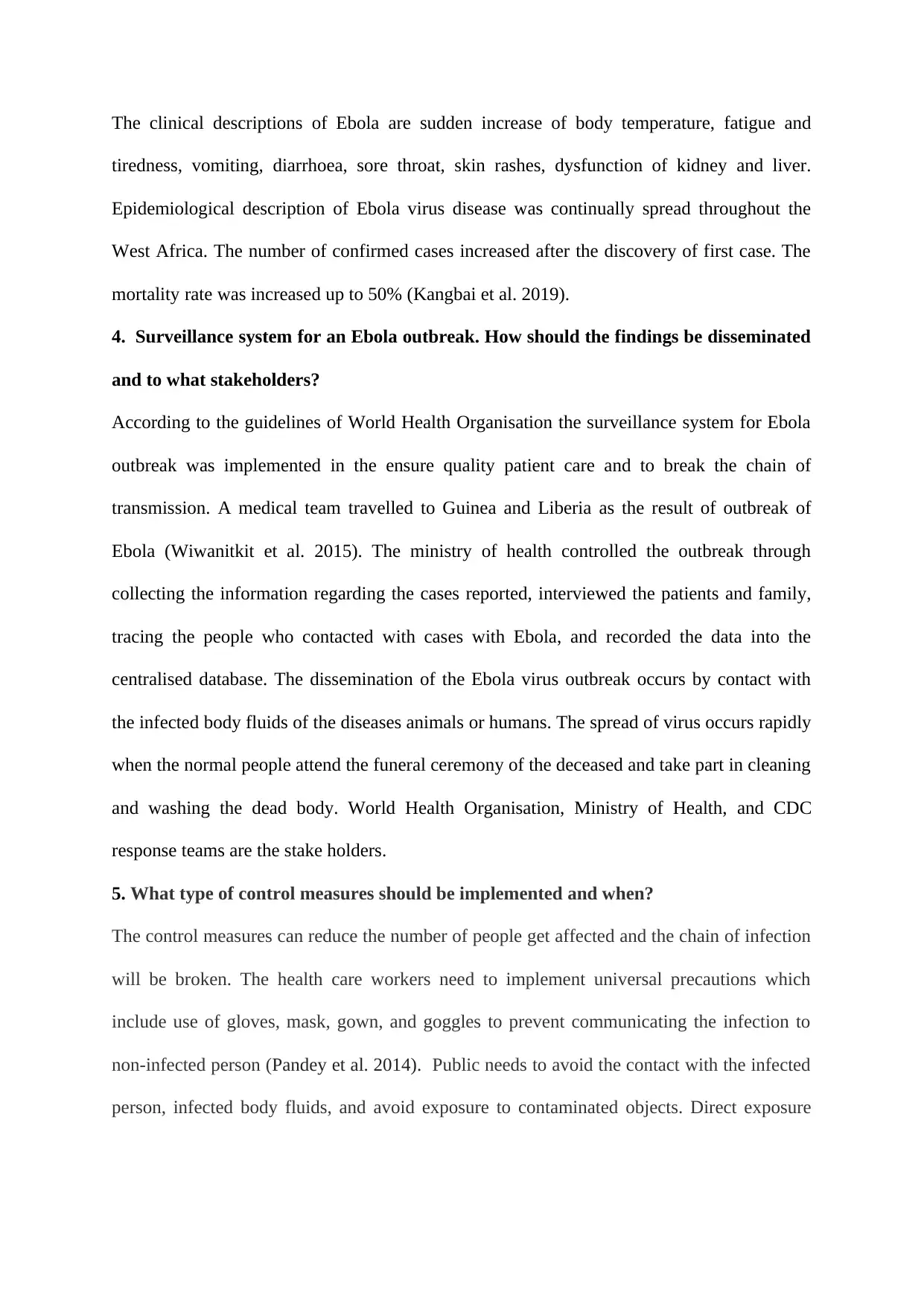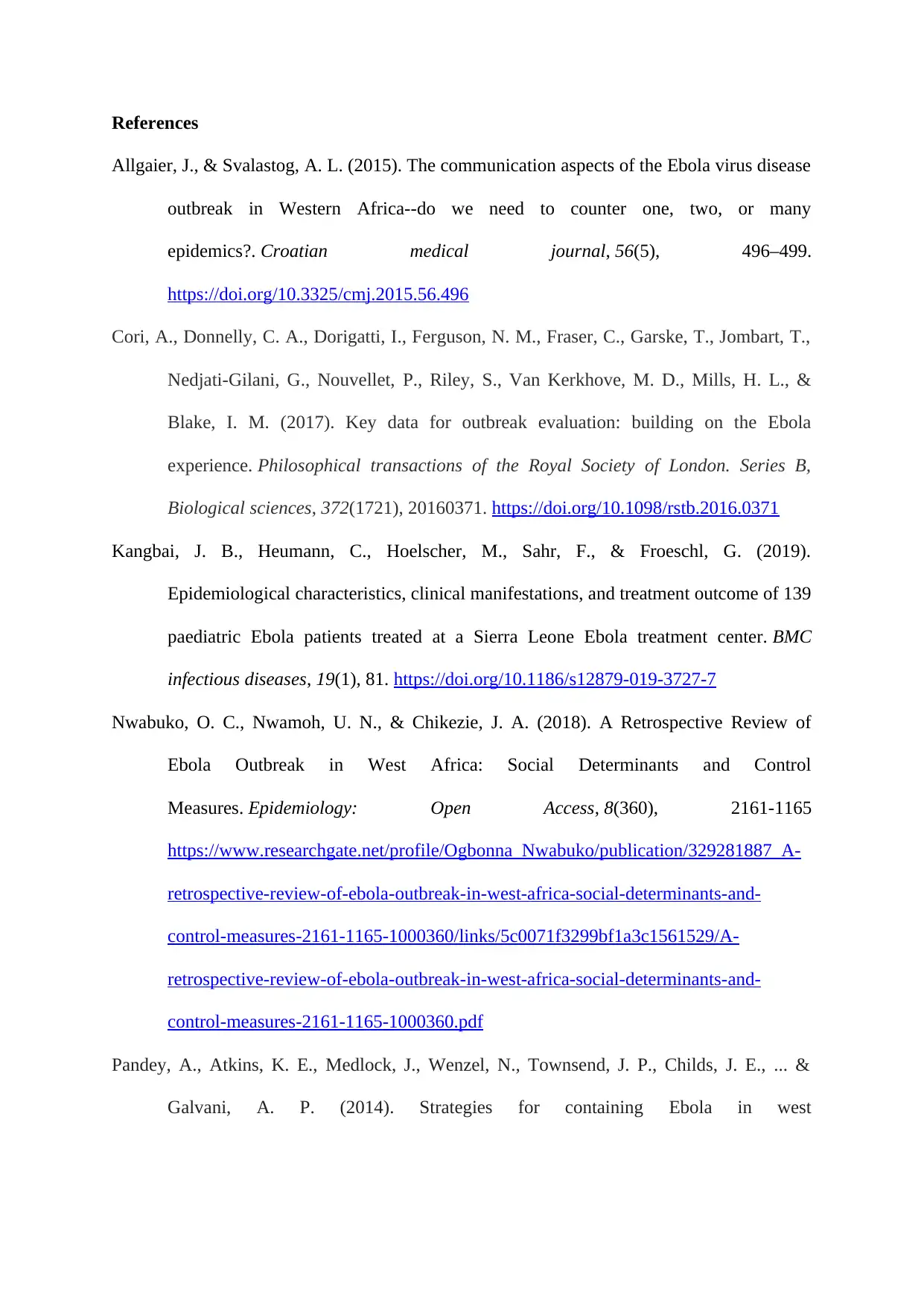HA533 Unit 1: Analysis of the Ebola Outbreak in West Africa
VerifiedAdded on 2022/08/27
|5
|1275
|25
Homework Assignment
AI Summary
This assignment delves into the 2014 Ebola outbreak in West Africa, examining its public health implications through a case study approach. It addresses key aspects such as the population affected, disease distribution, and determinants of the outbreak, highlighting the use of epidemiology to explain and predict its spread. The assignment explores the clinical versus epidemiological descriptions of the disease, proposes surveillance systems, and outlines essential control measures. Furthermore, it emphasizes the importance of data collection and presentation for effective outbreak management, including the need for digitalized data and the avoidance of manual presentation. The analysis covers the role of various stakeholders, including the World Health Organisation and the Ministry of Health, in controlling the outbreak.

Management of Ebola outbreak
1. What aspects of this case study exemplify the basic science of public health (e.g., the
population affected, distribution, determinants)?
The outbreak of Ebola in West Africa is one of the drastic endemics in history. Immediate
consideration was done by the Guinea Ministry of Health. According to the report of the
health department, the infection is featured by increased temperature, severe diarrhea, and
vomiting. The population affected was about 59% among 49 persons (Nwabuko, Nwamoh,
& Chikezie, 2018). The distribution of the disease was extended in all the direction First case
was discovered in Sierra Leone on 24 th May which was spread to Liberia, and Guinea.
During the mid of June, the total number of cases identified in all three countries was 528.
The outbreak was first started in the remote part of Guinea which was identified as a
mysterious disease. The determinants are handling ill or dead animals that are infected.
2. Describe how we can use epidemiology to explain and predict the Ebola outbreak.
What kind of questions should we attempt to answer?
According to report of World Health Organisation the outbreak of Ebola in West Africa was
the historical incident. The epidemiological analysis was done according to 26,593 cases
between the periods of March 2014 to may 2015. 11,020 deaths were reported in the month
of May. The increase of the number of fresh cases in three countries was reduced in number
which significantly shows the epidemiological changes of Ebola. When there were no new
cases identified in the month of June 2015 and the World Health Organisation declared that
the disease is eradicated. On comparing the peak season of Ebola outbreak, new cases was
decreased to 92.13% in Guinea (Allgaier, & Svalastog, 2015). The questions that can be
answered are the causes for the outbreak, epidemiological data, when the first case was
discovered and the number of cases identified and when the outbreak started.
3. Describe the clinical versus epidemiologic descriptions of the Ebola outbreak.
1. What aspects of this case study exemplify the basic science of public health (e.g., the
population affected, distribution, determinants)?
The outbreak of Ebola in West Africa is one of the drastic endemics in history. Immediate
consideration was done by the Guinea Ministry of Health. According to the report of the
health department, the infection is featured by increased temperature, severe diarrhea, and
vomiting. The population affected was about 59% among 49 persons (Nwabuko, Nwamoh,
& Chikezie, 2018). The distribution of the disease was extended in all the direction First case
was discovered in Sierra Leone on 24 th May which was spread to Liberia, and Guinea.
During the mid of June, the total number of cases identified in all three countries was 528.
The outbreak was first started in the remote part of Guinea which was identified as a
mysterious disease. The determinants are handling ill or dead animals that are infected.
2. Describe how we can use epidemiology to explain and predict the Ebola outbreak.
What kind of questions should we attempt to answer?
According to report of World Health Organisation the outbreak of Ebola in West Africa was
the historical incident. The epidemiological analysis was done according to 26,593 cases
between the periods of March 2014 to may 2015. 11,020 deaths were reported in the month
of May. The increase of the number of fresh cases in three countries was reduced in number
which significantly shows the epidemiological changes of Ebola. When there were no new
cases identified in the month of June 2015 and the World Health Organisation declared that
the disease is eradicated. On comparing the peak season of Ebola outbreak, new cases was
decreased to 92.13% in Guinea (Allgaier, & Svalastog, 2015). The questions that can be
answered are the causes for the outbreak, epidemiological data, when the first case was
discovered and the number of cases identified and when the outbreak started.
3. Describe the clinical versus epidemiologic descriptions of the Ebola outbreak.
Paraphrase This Document
Need a fresh take? Get an instant paraphrase of this document with our AI Paraphraser

The clinical descriptions of Ebola are sudden increase of body temperature, fatigue and
tiredness, vomiting, diarrhoea, sore throat, skin rashes, dysfunction of kidney and liver.
Epidemiological description of Ebola virus disease was continually spread throughout the
West Africa. The number of confirmed cases increased after the discovery of first case. The
mortality rate was increased up to 50% (Kangbai et al. 2019).
4. Surveillance system for an Ebola outbreak. How should the findings be disseminated
and to what stakeholders?
According to the guidelines of World Health Organisation the surveillance system for Ebola
outbreak was implemented in the ensure quality patient care and to break the chain of
transmission. A medical team travelled to Guinea and Liberia as the result of outbreak of
Ebola (Wiwanitkit et al. 2015). The ministry of health controlled the outbreak through
collecting the information regarding the cases reported, interviewed the patients and family,
tracing the people who contacted with cases with Ebola, and recorded the data into the
centralised database. The dissemination of the Ebola virus outbreak occurs by contact with
the infected body fluids of the diseases animals or humans. The spread of virus occurs rapidly
when the normal people attend the funeral ceremony of the deceased and take part in cleaning
and washing the dead body. World Health Organisation, Ministry of Health, and CDC
response teams are the stake holders.
5. What type of control measures should be implemented and when?
The control measures can reduce the number of people get affected and the chain of infection
will be broken. The health care workers need to implement universal precautions which
include use of gloves, mask, gown, and goggles to prevent communicating the infection to
non-infected person (Pandey et al. 2014). Public needs to avoid the contact with the infected
person, infected body fluids, and avoid exposure to contaminated objects. Direct exposure
tiredness, vomiting, diarrhoea, sore throat, skin rashes, dysfunction of kidney and liver.
Epidemiological description of Ebola virus disease was continually spread throughout the
West Africa. The number of confirmed cases increased after the discovery of first case. The
mortality rate was increased up to 50% (Kangbai et al. 2019).
4. Surveillance system for an Ebola outbreak. How should the findings be disseminated
and to what stakeholders?
According to the guidelines of World Health Organisation the surveillance system for Ebola
outbreak was implemented in the ensure quality patient care and to break the chain of
transmission. A medical team travelled to Guinea and Liberia as the result of outbreak of
Ebola (Wiwanitkit et al. 2015). The ministry of health controlled the outbreak through
collecting the information regarding the cases reported, interviewed the patients and family,
tracing the people who contacted with cases with Ebola, and recorded the data into the
centralised database. The dissemination of the Ebola virus outbreak occurs by contact with
the infected body fluids of the diseases animals or humans. The spread of virus occurs rapidly
when the normal people attend the funeral ceremony of the deceased and take part in cleaning
and washing the dead body. World Health Organisation, Ministry of Health, and CDC
response teams are the stake holders.
5. What type of control measures should be implemented and when?
The control measures can reduce the number of people get affected and the chain of infection
will be broken. The health care workers need to implement universal precautions which
include use of gloves, mask, gown, and goggles to prevent communicating the infection to
non-infected person (Pandey et al. 2014). Public needs to avoid the contact with the infected
person, infected body fluids, and avoid exposure to contaminated objects. Direct exposure

without protective equipment has to be avoided. The control measure need to be started when
there is the possibility of exposure to the Ebola infected person.
6. Are there other data that should be collected, and how should they be presented?
The data is the vital tool which aids in planning the management and control of outbreak. The
data that is essential in managing the Ebola outbreak are the severity rate, transmissibility,
transmission heterogeneities, and effectiveness of the management strategies, exposure data,
and data of affected population (Cori et al. 2017). The collected data need to be digitalized
primarily. The data has to analyse in various aspect for the present management and
prevention of Ebola outbreak in future. Electronic and digital inputs in maintain the data can
prevent confusion and meets the need. Manual presentation of data has to be avoided as it
may lead to errors.
there is the possibility of exposure to the Ebola infected person.
6. Are there other data that should be collected, and how should they be presented?
The data is the vital tool which aids in planning the management and control of outbreak. The
data that is essential in managing the Ebola outbreak are the severity rate, transmissibility,
transmission heterogeneities, and effectiveness of the management strategies, exposure data,
and data of affected population (Cori et al. 2017). The collected data need to be digitalized
primarily. The data has to analyse in various aspect for the present management and
prevention of Ebola outbreak in future. Electronic and digital inputs in maintain the data can
prevent confusion and meets the need. Manual presentation of data has to be avoided as it
may lead to errors.
⊘ This is a preview!⊘
Do you want full access?
Subscribe today to unlock all pages.

Trusted by 1+ million students worldwide

References
Allgaier, J., & Svalastog, A. L. (2015). The communication aspects of the Ebola virus disease
outbreak in Western Africa--do we need to counter one, two, or many
epidemics?. Croatian medical journal, 56(5), 496–499.
https://doi.org/10.3325/cmj.2015.56.496
Cori, A., Donnelly, C. A., Dorigatti, I., Ferguson, N. M., Fraser, C., Garske, T., Jombart, T.,
Nedjati-Gilani, G., Nouvellet, P., Riley, S., Van Kerkhove, M. D., Mills, H. L., &
Blake, I. M. (2017). Key data for outbreak evaluation: building on the Ebola
experience. Philosophical transactions of the Royal Society of London. Series B,
Biological sciences, 372(1721), 20160371. https://doi.org/10.1098/rstb.2016.0371
Kangbai, J. B., Heumann, C., Hoelscher, M., Sahr, F., & Froeschl, G. (2019).
Epidemiological characteristics, clinical manifestations, and treatment outcome of 139
paediatric Ebola patients treated at a Sierra Leone Ebola treatment center. BMC
infectious diseases, 19(1), 81. https://doi.org/10.1186/s12879-019-3727-7
Nwabuko, O. C., Nwamoh, U. N., & Chikezie, J. A. (2018). A Retrospective Review of
Ebola Outbreak in West Africa: Social Determinants and Control
Measures. Epidemiology: Open Access, 8(360), 2161-1165
https://www.researchgate.net/profile/Ogbonna_Nwabuko/publication/329281887_A-
retrospective-review-of-ebola-outbreak-in-west-africa-social-determinants-and-
control-measures-2161-1165-1000360/links/5c0071f3299bf1a3c1561529/A-
retrospective-review-of-ebola-outbreak-in-west-africa-social-determinants-and-
control-measures-2161-1165-1000360.pdf
Pandey, A., Atkins, K. E., Medlock, J., Wenzel, N., Townsend, J. P., Childs, J. E., ... &
Galvani, A. P. (2014). Strategies for containing Ebola in west
Allgaier, J., & Svalastog, A. L. (2015). The communication aspects of the Ebola virus disease
outbreak in Western Africa--do we need to counter one, two, or many
epidemics?. Croatian medical journal, 56(5), 496–499.
https://doi.org/10.3325/cmj.2015.56.496
Cori, A., Donnelly, C. A., Dorigatti, I., Ferguson, N. M., Fraser, C., Garske, T., Jombart, T.,
Nedjati-Gilani, G., Nouvellet, P., Riley, S., Van Kerkhove, M. D., Mills, H. L., &
Blake, I. M. (2017). Key data for outbreak evaluation: building on the Ebola
experience. Philosophical transactions of the Royal Society of London. Series B,
Biological sciences, 372(1721), 20160371. https://doi.org/10.1098/rstb.2016.0371
Kangbai, J. B., Heumann, C., Hoelscher, M., Sahr, F., & Froeschl, G. (2019).
Epidemiological characteristics, clinical manifestations, and treatment outcome of 139
paediatric Ebola patients treated at a Sierra Leone Ebola treatment center. BMC
infectious diseases, 19(1), 81. https://doi.org/10.1186/s12879-019-3727-7
Nwabuko, O. C., Nwamoh, U. N., & Chikezie, J. A. (2018). A Retrospective Review of
Ebola Outbreak in West Africa: Social Determinants and Control
Measures. Epidemiology: Open Access, 8(360), 2161-1165
https://www.researchgate.net/profile/Ogbonna_Nwabuko/publication/329281887_A-
retrospective-review-of-ebola-outbreak-in-west-africa-social-determinants-and-
control-measures-2161-1165-1000360/links/5c0071f3299bf1a3c1561529/A-
retrospective-review-of-ebola-outbreak-in-west-africa-social-determinants-and-
control-measures-2161-1165-1000360.pdf
Pandey, A., Atkins, K. E., Medlock, J., Wenzel, N., Townsend, J. P., Childs, J. E., ... &
Galvani, A. P. (2014). Strategies for containing Ebola in west
Paraphrase This Document
Need a fresh take? Get an instant paraphrase of this document with our AI Paraphraser

Africa. Science, 346(6212), 991-995
https://science.sciencemag.org/content/346/6212/991
Wiwanitkit, V., Tambo, E., Ugwu, E. C., Ngogang, J. Y., & Zhou, X. N. (2015). Are
surveillance response systems enough to effectively combat and contain the Ebola
outbreak?. Infectious diseases of poverty, 4(1), 7
https://link.springer.com/article/10.1186/2049-9957-4-7
https://science.sciencemag.org/content/346/6212/991
Wiwanitkit, V., Tambo, E., Ugwu, E. C., Ngogang, J. Y., & Zhou, X. N. (2015). Are
surveillance response systems enough to effectively combat and contain the Ebola
outbreak?. Infectious diseases of poverty, 4(1), 7
https://link.springer.com/article/10.1186/2049-9957-4-7
1 out of 5
Related Documents
Your All-in-One AI-Powered Toolkit for Academic Success.
+13062052269
info@desklib.com
Available 24*7 on WhatsApp / Email
![[object Object]](/_next/static/media/star-bottom.7253800d.svg)
Unlock your academic potential
Copyright © 2020–2025 A2Z Services. All Rights Reserved. Developed and managed by ZUCOL.





